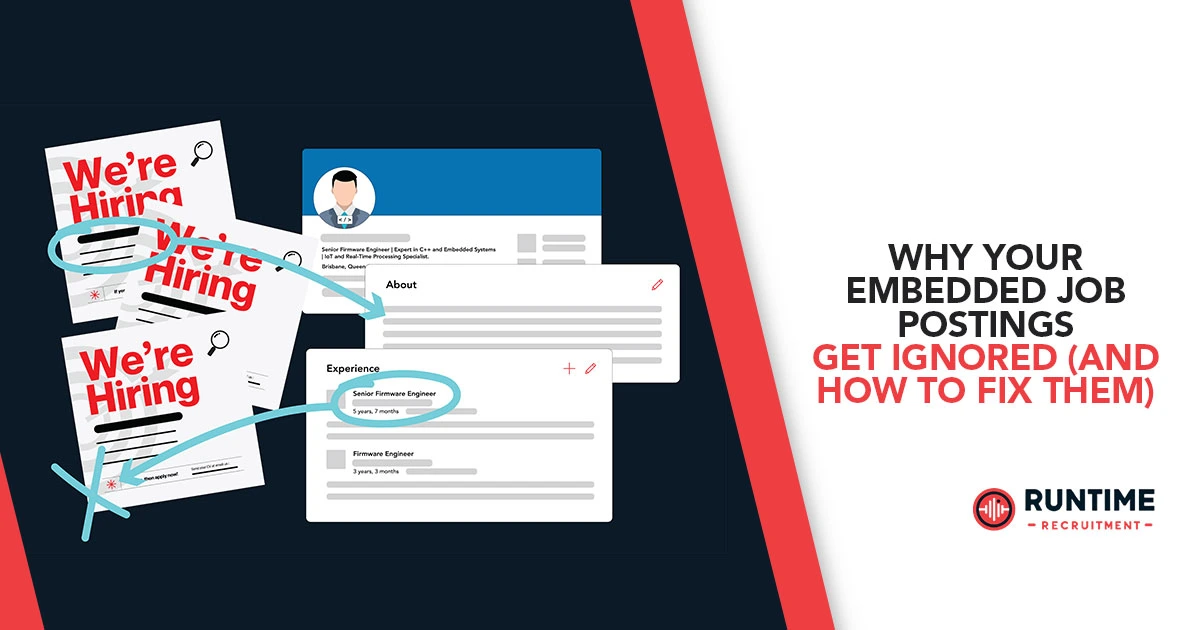The embedded systems landscape is a vibrant, innovative frontier, driving everything from life-saving medical devices to the next generation of autonomous vehicles. It’s a field demanding unique skill sets, rigorous attention to detail, and a profound understanding of the interplay between hardware and software. Yet, many companies find themselves baffled when their embedded engineering job postings, despite offering competitive salaries and exciting projects, gather dust instead of qualified applicants.
If your carefully crafted job descriptions are consistently met with silence or a deluge of irrelevant resumes, you’re not alone. The truth is, attracting top-tier embedded talent requires more than just listing technical requirements. It demands a strategic, empathetic approach that recognizes the nuances of this specialized engineering discipline and addresses the frustrations embedded engineers face in the modern job market.
This article delves deep into why your embedded job postings might be getting ignored, dissecting common pitfalls from the engineer’s perspective. More importantly, we’ll equip you with actionable strategies to transform your recruitment efforts, ensuring your next posting attracts the very best in embedded systems.
The Invisible Engineer: Why Your Postings Disappear into the Ether
Embedded engineers are problem-solvers by nature, often deeply immersed in their craft. Their work frequently involves complex, low-level programming, real-time operating systems (RTOS), intricate hardware interfaces, and stringent performance constraints. This dedication to technical mastery can sometimes make them “invisible” in a job market that often prioritizes buzzwords and superficial metrics over genuine technical depth.
Here are some of the primary reasons your embedded job postings might be failing to connect with the right talent:
1. Vague or Generic Job Descriptions: Speaking Generalities in a Niche World
The Problem: Many job descriptions for embedded roles read like templates. They list generic responsibilities, broad skill sets, and a boilerplate about “innovative environments.” This approach fails spectacularly for embedded engineers who thrive on specific challenges and technical detail. They want to know exactly what problems they’ll be solving, what technologies they’ll be working with, and the tangible impact of their contributions. A posting that could apply to any software engineer will be ignored by a specialist.
The Fix: Be excruciatingly specific.
- Highlight the Hardware: What specific microcontrollers, processors (e.g., ARM Cortex-M, RISC-V), or FPGAs will they interact with? Mention specific communication protocols (I2C, SPI, UART, CAN, Ethernet) if relevant.
- Detail the Software Stack: Are you using a particular RTOS (FreeRTOS, Zephyr, VxWorks)? Which programming languages are dominant (C, C++, Rust, Assembly)? What development tools (IDEs, debuggers, oscilloscopes, logic analyzers) are in play?
- Describe the Product/Project: Instead of “developing embedded systems,” describe the system. “Developing firmware for next-generation medical imaging devices,” or “Optimizing real-time control algorithms for autonomous drone navigation.” This paints a vivid picture.
- Quantify Impact: How will their work contribute to the product or company’s mission? “Your firmware will enable precise motor control, reducing energy consumption by 15%.”
2. Misunderstanding “Experience” vs. “Competence”: The Years-on-Resume Fallacy
The Problem: Recruiters often default to requesting a specific number of years of experience, say “5+ years embedded C++ experience.” While experience is valuable, it doesn’t always equate to competence or the ability to solve real-world embedded problems. An engineer with 3 years of hands-on experience debugging complex hardware issues and optimizing constrained systems might be far more valuable than someone with 7 years in a less challenging role. Furthermore, some postings focus on theoretical knowledge rather than practical application, missing engineers who can “deliver.” As Balemarthy Vamsi highlights, simply knowing a keyword like “volatile” isn’t enough; understanding its consequences in real hardware environments is what truly matters [Source 1].
The Fix: Focus on demonstrable skills and problem-solving aptitude.
- Shift to “Proficiency In”: Instead of “X years of experience,” state “Proficiency in embedded C/C++,” “Demonstrated experience with RTOS development,” or “Track record of debugging low-level hardware-software interactions.”
- Project-Based Questions: Encourage applicants to share personal projects, GitHub repositories, or examples of problems they’ve solved. This provides concrete evidence of their capabilities beyond a resume.
- Scenario-Based Interviewing: During interviews, present real-world embedded challenges and ask candidates to walk through their thought process, debugging steps, and potential solutions. This reveals how they “think, how they debug, how they break and build” [Source 1].
3. Ignoring the “Real World” of Embedded Development: The Disconnect
The Problem: Embedded systems exist in the messy real world, interacting with unpredictable hardware, external events, and tight constraints. Many job postings and subsequent interview processes fail to reflect this reality. They might focus solely on academic data structures or algorithms, neglecting crucial aspects like interrupt handling, memory management in constrained environments, power optimization, or real-time performance. Engineers often report that companies don’t value practical experience as much as academic qualifications.
The Fix: Align your recruitment process with the realities of embedded work.
- Emphasize Practical Skills: Look for experience with hardware debugging tools (oscilloscopes, logic analyzers, protocol analyzers), board bring-up, device drivers, and bootloader development.
- Discuss Constraints: Acknowledge and embrace the challenges of memory-constrained or power-sensitive environments. Engineers skilled in these areas are invaluable.
- Ask for “War Stories”: Encourage candidates to share anecdotes about tricky bugs they’ve solved, challenging hardware integrations, or successful system optimizations. These “war stories” demonstrate real-world problem-solving abilities [Source 1].
- Offer Hybrid/Onsite Options (When Necessary): While remote work is popular, embedded development often benefits from physical access to hardware. If onsite work is genuinely necessary, explain why and highlight the benefits (e.g., access to state-of-the-art labs, collaborative environment).
4. Lack of Employer Branding and Visibility: The Unknown Quantity
The Problem: Many companies expect embedded engineers to simply find their job postings on large job boards. However, as Balemarthy Vamsi points out, “70–80% of embedded openings in India are never posted publicly,” and a significant portion of hires come from referrals and relationships, not just portals [Source 2]. Engineers often prioritize working for companies with a clear mission, innovative projects, and a reputation for technical excellence. If your company doesn’t actively showcase its embedded work, culture, and technical challenges, you remain an “unknown quantity.”
The Fix: Build and leverage your employer brand within the embedded community.
- Showcase Your Work: Share blog posts, videos, or open-source projects demonstrating your embedded team’s innovations. Highlight the unique technical challenges you tackle.
- Engage with the Community: Participate in embedded conferences, meetups, and online forums. Contribute to open-source projects, and encourage your engineers to do the same. This builds trust and visibility.
- Tell Your Story: Showcase your company culture, the impact your products have, and the growth opportunities for embedded engineers. Engineers want to know they’ll be part of something meaningful.
- Leverage Employee Referrals: Incentivize your current embedded engineers to refer qualified candidates. Their network is often the most potent recruitment tool.
5. Inadequate Interview Processes: The Volatile Test
The Problem: Even if a posting attracts candidates, a poor interview process can deter top talent. Interviewers might ask overly theoretical questions, fail to assess practical skills, or not provide a clear picture of the role. For example, some interviews hinge on specific keyword knowledge, like volatile in C. While crucial, the true test isn’t memorization but understanding its real-world implications and when and why it’s used. Failing to understand an engineer’s practical application of such concepts can lead to misjudging their capabilities [Source 3].
The Fix: Streamline and enhance your interview process.
- Balanced Technical Assessments: Combine theoretical questions with practical coding challenges (e.g., on a microcontroller dev board), design discussions, and debugging exercises.
- Behavioral Questions with a Technical Twist: Ask candidates about their approach to problem-solving, how they handle setbacks, or how they collaborate, but ground these in embedded engineering scenarios.
- Transparent Process: Clearly communicate the interview stages, what to expect, and the timeline. Respect candidates’ time.
- Engage Embedded Engineers in Interviewing: Ensure that current embedded engineers are heavily involved in the interview process. They can best assess technical fit and answer candidates’ in-depth questions.
- Provide a Realistic Job Preview: Through discussions and perhaps a brief tour (if onsite), give candidates a clear understanding of the day-to-day work, team dynamics, and challenges.
How RunTime Recruitment Tackles the Problem
Addressing these challenges requires deep expertise and a nuanced understanding of the embedded systems domain. This is precisely where RunTime Recruitment distinguishes itself. Unlike traditional recruitment agencies, RunTime Recruitment operates with a profound specialization in technical recruitment for sectors like Embedded Systems, Firmware, IoT, Medical Devices, Automotive, Defense, and Industrial Control.
Their core strength lies in their team’s background in these very fields. This direct experience allows them to:
- Understand Technical Specifications: They speak the language of embedded engineers, accurately interpreting complex technical requirements from hiring managers and translating them into compelling, precise job descriptions that resonate with candidates.
- Refine Job Descriptions: RunTime Recruitment doesn’t just repost job ads; they work with companies to refine existing descriptions, ensuring they are detailed, accurate, and appealing to the specific embedded talent being sought. They help companies move beyond generic templates to truly highlight the unique technical challenges and opportunities.
- Effective Communication: Their technical grounding enables them to communicate effectively with development teams, bridging the gap between HR and engineering departments. This ensures that the nuances of an embedded role are fully understood and conveyed to potential candidates.
- Precision Matching: They go beyond simply matching keywords on a resume. RunTime Recruitment focuses on “precision matching,” ensuring that candidates not only possess the required technical skills but also align with a company’s vision, culture, and specific project needs. This means filtering out irrelevant applicants and presenting only highly qualified and culturally compatible profiles.
- Pre-Screening and Vetting: They conduct rigorous pre-screening, verifying technical skills and checking references, saving companies significant time and effort in the initial stages of recruitment. This ensures that the candidates presented are genuinely capable of delivering results from day one.
- Candidate Support: RunTime Recruitment offers “white-glove candidate support,” preparing engineers for interviews and assisting with onboarding. This professional approach enhances the candidate experience and improves the likelihood of a successful hire.
By leveraging RunTime Recruitment’s specialized expertise, companies can transform their embedded job postings from ignored listings into powerful magnets for top-tier talent. They address the fundamental disconnects, ensuring that job opportunities are not only visible but also deeply appealing to the discerning embedded engineering community.
Conclusion
The embedded engineering talent pool is a highly skilled, discerning group. They are driven by meaningful technical challenges, opportunities for deep problem-solving, and a desire to contribute to cutting-edge products. When your job postings get ignored, it’s often a symptom of a broader misalignment between your recruitment approach and the unique expectations of this specialist community.
To fix this, companies must move beyond generic job descriptions and superficial requirements. They need to embrace transparency, technical specificity, and a recruitment process that reflects the real-world demands of embedded development. By showcasing the intricate hardware, the challenging software problems, and the tangible impact an engineer can make, you begin to speak their language.
Partnering with a specialized firm like RunTime Recruitment can provide the necessary technical insight and strategic approach to navigate this complex landscape. Their ability to understand, articulate, and vet embedded roles ensures that your valuable job opportunities don’t just exist but truly resonate with the engineers you need.
Ready to find the perfect embedded engineer for your team?
Don’t let your ideal candidate scroll past your next job posting. If you’re struggling to attract top-tier embedded talent and want to ensure your roles are filled with precision-matched professionals, it’s time to connect with the experts.
RunTime Recruitment understands the intricacies of the embedded world and can pinpoint candidates who not only possess the right technical skills but also align with your company’s vision and culture.
Reach out to RunTime Recruitment today and discover how their specialized technical recruitment expertise can help you attract and secure the right candidate for your critical embedded engineering roles.









